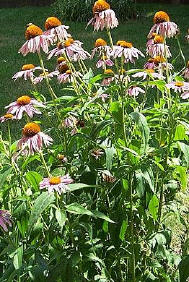 Many gardeners wonder if they shouldn't cut down and clear out the summer growth fearing it might lead to disease and insect problems for next spring. This question, as so many gardening inquiries, can be answered one sure way: It
depends.
Many gardeners wonder if they shouldn't cut down and clear out the summer growth fearing it might lead to disease and insect problems for next spring. This question, as so many gardening inquiries, can be answered one sure way: It
depends.
The kind of garden you are growing will determine how much "cleaning" you need to do at the end of the season. How concerned you and your neighbors are about yard neatness may also be a factor. If you grow annuals, tropicals, vegetables,
wildflowers, have a woods or a plain lawn, your style will set your work schedule.
One subject we learn about as master gardeners is integrated pest management (IPM). This term describes a decision making approach to gardening that is gaining popularity as more people learn the principles. You can actually do less in
your yard and let nature work for you. Doing a big fall clean up may mot be as necessary as you once thought.
|

Purple Cone Flower
Echinacea purpurea |
If it's possible, leave some perennials standing. It's fun to watch finches on coneflowers (Echinacea sp.) picking out the seeds. Sunflowers, liatris and other flowers that go to seed will provide food for wildlife. Watching birds can
give you hours of enjoyment in the winter garden. Leaving flowers and stalks through the winter will also provide homes for overwintering insects. Gardeners familiar with IPM will welcome insects as pollinators and as food for birds and each other. An environmentally
friendly garden will always have lots of bugs in it. By leaving seed heads and some winter protection for birds and insects in your garden, you'll have lots of wildlife to enjoy this fall and winter. Milkweed pods provide seeds for food and flycatchers, vireos, wrens, some
warblers, sparrows, orioles and finches will use the floss for nesting. You'll have more insects in the spring, too.
This is not a punishment for laziness but a reward for allowing nature to take care of itself. In spring, migrating birds will come looking for those insects and visit the garden that provides food.
When you simply must cut down perennial stalks, chop them into six-inch lengths (or so) and pile them in the garden as mulch with fall leaves. Stick piles give cover for wildlife, including overwintering butterflies like the Mourning
cloak. The leaves and plant material you leave on the ground will mulch the garden and can be turned in to the soil in spring, adding important organic material.
Some work you will want to take care of this fall. Cut down and discard diseased plant material as a hygienic step. Remove this spent growth; don't use it in your compost pile.
Vegetable gardens will need to be cleared of old growth, to assure the best conditions for next year's crop. Prune back plants and shrubs with seed heads that start too many unwanted new plants. An example is the ubiquitous butterfly
bush. Established Buddleia can be cut down to a foot high and regrow beautifully next season. Tropicals take a lot of care in this non-tropical area. I used to spend my October digging up, drying out and preparing to store cannas, glads, and dahlias. Plants that naturally
grow here (and many are beautiful additions to your yard) will not take up your time, effort, and basement with the coddling that non-natives require. Do a little research with the Maryland Native Plant Society (on-line at www.mdflora.org) and trade those labor-intensive
tropicals for plants that grow in our climate naturally.
Visit a garden where natives are in the spotlight at the County Extension Office on Montevue Lane in Frederick. This addition to the Master Gardener's demonstration garden is just beginning but promises educational opportunities for
those looking to tune into natural gardening practices.
You won't be checking hardiness zone maps or bringing in pots and bulbs to sit out the harsh winter because native plants evolved to live right here. Look for plants native to your back yard and they'll flourish in the natural soil,
temperature range and water available. They'll repay you with less garden work and more garden enjoyment.
Your spouse or neighbors may ask why you've left some of your garden standing through the winter. It can take some getting used to, if you normally clear everything out of your garden in the fall. Take small steps at first. And while
you're saving time by not cleaning out your garden, fall is the time to clean, sharpen and oil your tools. They'll be ready to make our spring work easier.
Read other articles on ecological gardening & native plants
Read other fall related gardening articles